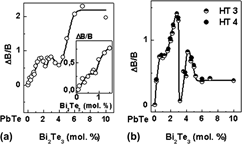Crossref Citations
This article has been cited by the following publications. This list is generated based on data provided by
Crossref.
Rogacheva, E.I.
Vodorez, O.S.
and
Nashchekina, O.N.
2013.
Oscillations of transport properties in PbTe–Bi2Te3 solid solutions.
Journal of Physics and Chemistry of Solids,
Vol. 74,
Issue. 1,
p.
35.
Falkenbach, Oliver
Hartung, David
Klar, Peter J.
Koch, Guenter
and
Schlecht, Sabine
2014.
Thermoelectric Properties of Nanostructured Bismuth-Doped Lead Telluride Bi x (PbTe)1−x Prepared by Co-Ball-Milling.
Journal of Electronic Materials,
Vol. 43,
Issue. 6,
p.
1674.
Rogacheva, E. I.
Vodorez, O. S.
Nashchekina, O. N.
and
Dresselhaus, M. S.
2014.
Concentration anomalies of the thermal conductivity in PbTe-PbSe semiconductor solid solutions.
physica status solidi (b),
Vol. 251,
Issue. 6,
p.
1231.
Yang, Lei
Chen, Zhi-Gang
Hong, Min
Wang, Lihua
Kong, Deli
Huang, Liqing
Han, Guang
Zou, Yichao
Dargusch, Matthew
and
Zou, Jin
2017.
n-type Bi-doped PbTe Nanocubes with Enhanced Thermoelectric Performance.
Nano Energy,
Vol. 31,
Issue. ,
p.
105.
Ben-Ayoun, Dana
and
Gelbstein, Yaniv
2019.
Advanced Thermoelectric Materials for Energy Harvesting Applications.
Rogacheva, Elena
and
Nashchekina, Olga
2019.
Advanced Thermoelectric Materials.
p.
383.
2019.
Percolation effects and self-organization processes in Bi2(Te1-xSex)3 solid solutions.
Functional materials,
Vol. 26,
Issue. 2,
Rogacheva, Elena I.
Nikolaenko, Ganna M.
Meriuts, Andriy V.
and
Nashchekina, Olga N.
2024.
Percolation phase transition, self-organization processes and thermal conductivity in PbSe
1-x
Te
x
semiconductor solid solutions at small Te concentration
.
Phase Transitions,
Vol. 97,
Issue. 7-8,
p.
508.
Rogachova, Olena
Menshikova, Svitlana
Martynova, Kateryna
Nashchekina, Olga
Shelest, Tetiana
and
Meriuts, Andrii
2024.
Effect of Transition to Impurity Continuum on Thermoelectric Properties of the Semiconductor $\left(\text{Bi}_{1-\mathrm{x}} \text{Sb}_{\mathrm{x}}\right)_{2} \text{Se}_{3}$ Solid Solutions.
p.
1.
